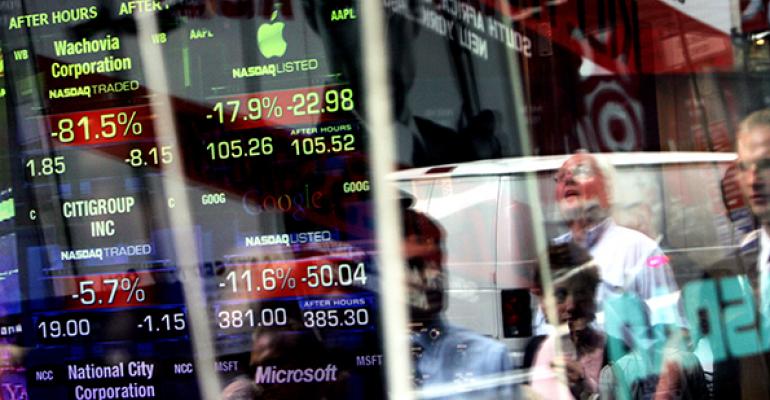By Sid Verma
(Bloomberg) --Rising political risks. A fading era of central-bank stimulus. The potential end of a multi-decade bull run in U.S. government debt.
Markets have so far this year shrugged off a laundry list of looming headwinds, with U.S. equities scaling new heights and sales of corporate bonds reaching record levels.
What gives?
While major economies have shown signs of improvement in recent months, helping to rekindle investors’ animal spirits, a key and typically over-looked technical indicator has helped juice the global rally in financial assets: supply.
Net supply of global equities, for example, may flatline this year after falling into negative territory in 2016 for the first time on record, according to JPMorgan Chase & Co. Meanwhile, bond investors in Europe, the U.S., and emerging markets are poised to become cash-rich in the coming months thanks to an avalanche of maturing debt -- a dynamic which should help them soak up fresh sales.
In both the equity and bond markets, the implications are the same. A benign supply outlook is a positive market technical for corporate financing conditions around the world that may lend support to asset valuations and provide a cushion against the slew of event risks looming this year, including elections in Europe and U.S.-fueled trade wars.
A First for Equities
Analysts at JPMorgan paint a stark illustration of this positive picture for market technicals. They calculate that global equity supply fell into negative territory last year for the first time ever, as share buybacks, mergers and leveraged buyouts offset public offerings and other corporate activities that tend to increase the amount of shares outstanding, such as rights issues and employee stock programs.
“The decline in equity supply last year created a support for equity markets, largely offsetting the decline in demand by retail investors,” Nikolaos Panigirtzoglou, who leads the U.S. bank’s flow-and liquidity team, wrote in a report published last week.
Even if retail investors continue to demonstrate limited appetite for stocks relative to bonds, a benign supply story may continue to lift equity markets this year, the strategists concluded.
“Into 2017, we expect global equity supply to remain close to zero. A projected increase in equity offerings is likely to be offset by stronger equity withdrawal as repatriation bolsters U.S. share buybacks,” they said.
Buoyant Bonds
The market for new corporate bonds denominated in euros and dollars has been on fire this year -- sales of U.S. investment-grade debt set an all-time monthly record in January after reaching $185 billion, according to Bloomberg Intelligence -- as companies seek to fund themselves ahead of expected U.S. interest rate hikes. But the glut is less fierce when taking into account ample investor firepower this year, a positive technical that may help to keep credit spreads in check.
Net supply of new U.S. investment-grade debt could decline by as much as 31 percent to $511 billion in 2017 thanks to a wave of maturing bonds and coupon payments, Bank of America Corp. analysts calculated in November. That would signal a sharp reduction in the supply of debt issued by companies with stronger balance sheets compared with the roughly $200 billion in new annual funding needs notched in the previous four years.
What’s more, corporate bond issuance in euros has been decidedly modest in recent months in both investment-grade and high-yield markets after taking into account a rise in maturing debt. Net supply of euro-denominated bonds issued by riskier firms has been flat over the past three months, according to Citigroup Inc., helping to drive yields to record lows.
Who Needs the ECB?
Meanwhile, the outstanding stock of euro-denominated investment-grade debt shrunk by 28 billion euros ($30 billion) between December and January -- all before the European Central Bank purchased a single bond -- thanks to a wave of redemptions, according to Citi.
It’s a similar story for bonds sold by companies in developing countries. Emerging market corporate bond redemptions in euros and dollars will increase to $165 billion from $97 billion in 2016, Barclays Plc analysts calculated in November. That suggests primary markets should be able to digest any year-on-year increase in gross corporate debt supply.
And then there’s the demand picture.
Resilient interest from buyers continues to buoy global debt markets, as the so-called great rotation -- a projected flood of capital migrating out of bond markets and into stocks -- has yet to materialize.
The four-week moving average of fund flows into U.S. equity funds has fallen to zero, while capital flowing into U.S. bond funds has surged to a six-month high, according to a Goldman Sachs Group Inc. report this week, citing EPFR Global data.
In short, a world with excess savings is still struggling to sate its appetite for investable assets in public markets, amid a net shortage of new stocks and corporate bonds.
To contact the reporter on this story: Sid Verma in London at [email protected] To contact the editors responsible for this story: Tracy Alloway at [email protected] Samuel Potter





